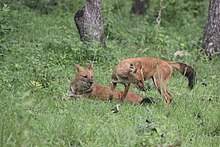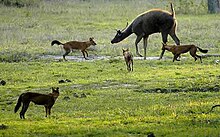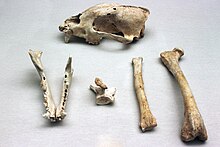Cuon alpinus
The howon, dole, red dog, jaro dog, Asian wild dog b> or Indian wild dog (Cuon alpinus) is a species of carnivorous mammal in the family Canidae. It is the only extant member of the genus Cuon, which differs from Canis by the reduced number of molars and a greater number of teats. It has the same size and a great resemblance to the coyote, but differs from it by its reddish fur and the fact that it is a social animal that lives in clans. Jaro dogs are classified as endangered by the International Union for Conservation of Nature (IUCN), due to progressive loss of habitat, disappearance of their prey, competition with other predators, disease, and possibly extinction. persecution by domestic and feral dogs.
They are highly social animals that live in large clans, sometimes splitting up into small groups to hunt. They feed mainly on medium-sized ungulates, which hunt for persistence after long chases, and kill by disembowelment. Unlike most social canids (but like African wild dogs), dungs let their young eat first after a hunt. Although fearful of man, the groups dare to attack large and dangerous animals such as wild boar, water buffalo and even tigers.
Taxonomy
George Gaylord Simpson classified quaons in the subfamily Symocyoninae, along with African wild dogs and bush dogs, because they share anatomical features, such as the reduction of post-butcher molars. Many have questioned this classification, arguing that these common features are due to convergent evolution. Juliet Clutton-Brock, after comparing the morphological, ethological and ecological characteristics of 39 different canid species, concluded that, with the exception of the skull and teeth, the quaons were most similar to canids of the genera Canis, Dusicyon and Alopex than to African wild dogs and bush dogs. A comparative study on the mitochondrial DNA of the cuon and other canids in 1997 showed that the cuons diverged from the Canis lupus lineage before the black-backed jackal and the golden jackal, a couple of million years ago..
Subspecies
- Cuon alpinus alpinus or oriental cuon: the largest of the subspecies. Speaks in the southeast of China, India, Nepal, Bhutan, Bangladesh, Burma, Thailand, Laos, Cambodia and Vietnam.
- Cuon alpinus hesperius or western cuon: small subspecies that currently only inhabits in western China.
- Cuon alpinus sumatrensis o Cuon of Sumatra: small size subspecies that lives on the islands of Sumatra and Java.
- Cuon alpinus priscus †: lived during the first half of Pleistocene.
- Cuon alpinus fossilis †: used Europe during the second half of Pleistocene. It was an intermediate way between C. a. priscus and C. a. europaeus.
- Cuon alpinus europaeus †: lived throughout Europe at the end of Pleistocene. It was the last cuons to inhabit the European continent.
Evolution
Quons come from the Pleistocene, and are more closely related to jackals than wolves. It has been theorized that they became social animals as an adaptation to survive in the face of large predators. Although they only exist today in eastern Asia, Pleistocene fossil beds indicate that these animals also once inhabited Europe and even North America.
Description
Anatomy
They have a relatively short, heavy, and massive skull, with shortened facial regions, widely spaced zygomatic arches, and a well-developed sagittal crest. The frontal bone is bulged forward, giving the animals a convex rather than a concave profile. The masseter muscles are highly developed compared to other canid species, giving the face an almost hyena-like appearance. The skull is broader, and it has a shorter rostrum than domestic dogs and most other canids. The dental formula is 3.1.4.2, both for the maxilla and the mandible.
The species has only 6 lower molars, instead of 7. The upper molars are weak, being 2-3 times smaller than those of wolves, and have only one cusp, instead of 2-4, as is the case. common in canids. This adaptation improves cutting ability, allowing it to compete more successfully with kleptoparasites. The canine teeth are slightly curved and short.
Its limbs are moderately long, and its thorax is proportional. They have great leaping ability and can make long jumps, up to 3.5m high and 5-6m long. The length of its tail is 40 to 43 cm, which is almost half the length of its body. Adult males can reach 18 kg in weight, and females 13.5 kg on average. They measure from 43 to 56 cm in height at the withers and 91 cm in length. Similar to African wild dogs, the ears are rounded rather than pointed. Unlike that species, however, male quaons do not have a clearly visible foreskin, making sexing of individuals difficult, even by close observation. Unlike members of the Canis family, females have 12 or 14 nipples, instead of 10. They are not as odorous as wolves, jackals, and foxes, as they have fewer scent glands. annals. It has been estimated that its stomach can hold 2.9 kg of ingested food.
Fur
The general tone is reddish, becoming more intense during winter. When in winter coat, the back is rusty red with brown patches on the top of the head, neck, and shoulders. The throat, chest, flanks, belly, and upper limbs are less intense in color, more of a yellowish hue. The lower parts of the limbs are white, with dark brown stripes on the front of the forelimbs. The forehead and muzzle are reddish grey. The tail is very lush and fluffy, and mainly ocher-red in color, with a dark brown tip. The summer coat is shorter, thicker, and darker. Dorsal and lateral covert hairs are 2–3 cm long. Cues at the Moscow Zoo shed their hair once a year, from March to May.
Behavior
Social and territorial behavior
They are more social than wolves and have a lower dominance hierarchy, as seasonal food scarcity is not as marked as it is with wolves. In this regard, they closely resemble African wild dogs in social structure. Dominant quons are difficult to identify, as they do not engage in dominance displays as wolves do, even though other clan members display submissive behavior towards them. They live in clans instead of packs, as the latter term refers to a group of animals that always hunt together. In contrast, clans of quons often separate into small groups of 3-5 animals, especially during the spring season, as this is the optimum number for taking ungulate pups. They are far less territorial than wolves, and newly emancipated young from one clan often join another without issue. In India, clans are generally made up of 5 to 12 individuals, although clans of 40 have been reported. In Thailand, clans rarely exceed 3 individuals. Unlike other canids, there is no evidence that quaons use urine to mark their territories or paths of travel. They sometimes defecate in conspicuous places, but it seems unlikely that this has a territorial function, as feces are mostly deposited within the clan's territory rather than the periphery. The feces are usually deposited in what appear to be community latrines. They don't scratch the ground with their feet like other canids do to mark their territories.
Playback
The mating season for Indian cuons is between mid-October and January, while at the Moscow Zoo they breed mainly in February. Unlike wolf packs, wolves can contain more than one breeding female. During mating, the female squats, similar to cats. There is no typical "knotting" of other canids when the male dismounts. The gestation period lasts from 60 to 63 days, with a litter size of between 4 and 6 pups. Their growth rate is much faster than that of wolves, being similar to that of coyotes. The cubs are nursed until the age of 58 days, at least. During this time, the pack feeds the mother in the den. They do not use gathering points to care for their pups as wolves do, although one or more adults will stay with the pups in the den while the rest of the pack hunts. Once weaning begins, the adults of the clan regurgitate food to the young until the young are old enough to participate in the hunt. The young remain in the burrow until the age of 70 to 80 days. At the age of 6 months, they accompany adults on the hunt, and help kill sambar-sized prey at the age of 8 months.
Diet and hunting
Their prey in India include chital, sambar, mummy, mouse-deer, swamp deer, wild boar, gaur, water buffalo, banteng, cattle, nilgos, goats, hares of the India, the field rats of the Himalayas and langurs. There is a record of a herd shooting down an Indian elephant calf in Assam, despite the desperate defense of the mother resulting in heavy casualties in the herd. In Kashmir they may hunt markhores, and in Burma Eld's deer. In Java they hunt Timor deer. In the Tian Shan and Tarbagatai Mountains, Jaro dogs prey on Siberian ibex, urials, Siberian roe deer, Caspian deer, and wild boar. In the Altai and Sayan Mountains they fed on Siberian musk deer and reindeer. In eastern Siberia they preyed on roe deer, Manchurian elk, wild boar, musk deer and reindeer, while in Primorsky Krai they preyed on sika deer and goral. In Mongolia they fed on argals and rarely on the Siberian ibex. Like African wild dogs, but unlike wolves, dungs are not known to attack people. They also eat fruit and plant matter more easily than other canids. In captivity, they eat various types of grasses, herbs and leaves, apparently for pleasure and not just when sick. In summer in the Tien Shan mountains, cuons eat large amounts of mountain rhubarb. They also consume the fruits of the Bengal quince. Despite being opportunistic animals, they appear to have an aversion to hunting cattle and their young. Predation on domestic animals has been a problem in Bhutan since the late 1990s, as domestic animals are often left loose to graze in the forest, sometimes for weeks. Cattle that are kept at night and those that graze near houses are not attacked. Oxen die more frequently than cows, probably because they are given less protection.
Before embarking on a hunt, clans perform elaborate social rituals in which they rub each other's bodies and engage in homosexual and heterosexual copulation. Quons are primarily diurnal hunters, hunting in the early morning hours. They rarely hunt at night, except on nights with a full moon, indicating that they rely heavily on sight for hunting. Although not as fast as jackals and foxes, they can chase their prey for many hours. During a chase, one or more quaons may take over in pursuit of prey, while the rest of the pack keeps a more sustained pace behind, other marching groups taking over on more than one occasion. Most chases are short, lasting only 500 meters. When chasing fast prey, they run at a rate of 30 miles per hour. Jaro dogs frequently cause their prey to enter bodies of water, where the animal's movements are affected.
When large prey is captured, one cuon holds onto the prey's snout, while the rest of the pack tackles the animal from the flanks and hindquarters. They do not use a deadly bite to the throat. Sometimes they blind their prey by attacking the eyes. Seraus are among the few ungulates that can defend themselves effectively against quan attacks, due to their thick fur and short, sharp horns that can easily pierce a quan. Quons tear through the sides of their prey and disembowel it, eating the heart, liver, lungs, and sections of the intestines. The stomach and rumen are generally not consumed. Game under 50 kg are usually killed within two minutes, while large deer can take 15 minutes to die. Once the prey is secured, jaro dogs tear off pieces of the carcass and eat separately. Unlike wolf packs, in which the breeding pair has preference for feeding, dungs give pups priority when they come to the kill, allowing them to eat first. They are generally tolerant of scavengers.
Relationships with other predators
In some areas, cuons coexist with tigers and leopards. Competition between the three species is mainly avoided by differences in prey selection, even though they significantly overlap on many points. Leopards and cuons typically select animals ranging in weight from 30 to 175 kg (mean 35.3 kg for the cuon and 23.4 kg for the leopard), while tigers prey on animals weighing more than 176 kg. (although the average weight of their prey is 65.5 kg). In addition, other prey characteristics, such as sex, tree habits, and aggressiveness, can influence prey selection. For example, cuons preferentially select male chitals, while leopards hunt both sexes more evenly (tigers tend to prefer larger prey). Wows and tigers rarely kill langurs compared to leopards, due to the latter having more arboreal habits. In contrast, the leopard kills wild boar infrequently, due to the inability of this relatively light predator to cope with such aggressive prey of similar weight. They came to attack tigers on extremely rare occasions, since the quans fear them, and they do it for protection, because they do not see the tiger as prey. When confronted, tigers seek shelter in trees or stand upright with their backs to a tree or bush, where they may be harassed for a long time before finally trying to escape. It has rarely been documented that a tiger has been killed by the quans, and it has occurred on occasions where he has escaped, while the tigers that are kept in place have an almost assured chance of survival. Tigers are very dangerous opponents, as they are strong enough to kill a cuon with a single claw. Even the successful kill of a tiger is accompanied by the death of the majority of the pack, which is why cuons in even large packs tend to run away when they see one. In fact, cuons are frequently hunted by tigers, with which they also often lose prey and young. Herds of cuons can rob a leopard of its prey, while leopards can kill cuons if found singly or in pairs. Because leopards are smaller than tigers and have a more similar diet, jaro dog packs tend to react more aggressively towards them than towards tigers. Quons were thought to have played a significant role in reducing Asian cheetah populations, but this seems doubtful as cheetahs live in open areas compared to forested areas which cheetahs prefer.
Packs of cuons occasionally attack Tibetan bears and sloth bears. When they attack these, the quans try to prevent them from taking refuge in caves and bite their hindquarters.
Although antagonistic to the wolf, both (the cuon and the wolf) can hunt and feed by sharing territory. Domestic dogs can kill quaons, although they are occasionally fed with them.
Distribution
Prehistoric
During the last glacial period they ranged across most of Eurasia, and are known to have once inhabited North America from a single fossil found in the Gulf of Mexico. Another canid, called the Sardinian cuon (Cynotherium sardous), lived on the Mediterranean island of Sardinia during the Pleistocene, but it is not closely related to the present species despite what its common name might suggest. The cuon has been documented in the Iberian Peninsula in archaeological and paleontological contexts from the Middle and Late Pleistocene and a possible survival of the species until the early Holocene has been raised.
Historical
They once inhabited most of South, East, and Southeast Asia, stretching from the Tian Shan and Altai Mountains and Primorsky Krai south through Mongolia, Korea, China, Tibet, Nepal, India, and to the southeast in Burma and Indochina, Thailand, Malaysia, Sumatra, and Java.
Current
There are currently no reports of quaons in Russia, Mongolia, Kazakhstan, Kyrgyzstan, and Tajikistan. There is a report of a cuon being captured in the Jiangxi district of China. They still exist in Tibet, particularly in the Ladakh region, the border between India and southeastern Tibet. They may still be present in North Korea. They are still found in India south of the Ganges River, especially in the Indian Central Highlands and in the Eastern and Western Ghats. Quons also exist in the north-eastern Indian states of Arunachal Pradesh, Assam, Meghalaya and West Bengal. They have a precarious and fragmented distribution in the Himalayas and northwestern India. They are occasionally documented in the Ladakh area of Kashmir, contiguous to the highlands of Tibet and China. In Nepal, cuons were previously recorded in the Terai, including Royal Chitwan National Park. Cuons were documented in the Dhorpatan Game Reserve in the late 1990s. In Bhutan cuons have recovered after the Government promoted a poisoning campaign in the 1970s, with reports of cattle raids occurring in the region of the under Kheng. It is not known if they still exist in Bangladesh. Quons have been confirmed by camera traps to still be present in 11 study areas in Burma, where they have replaced tigers as top predators. Jaro dog populations are highly fragmented in Thailand and Indochina, particularly Vietnam. Quons are known to exist in four areas of northern and central Malaysia. In Java they appear to be most common in protected areas on the eastern and western ends of the island. They are also known to live in protected areas of Sumatra in the southern, central and northern areas.
In 2015, there were only 2,500 specimens left in the wild, and scientists believe it is on the way to prompt extinction if effective conservation measures are not taken and habitat loss and poisoning by ranchers is stopped.
Pop Culture
In the Second Jungle Book, Kipling describes dholes as very fierce, bloodthirsty and determined wild dogs. In a chapter of the book, they face the protagonist Mowgli, who, together with the wolves, defeats them.
Contenido relacionado
Lagomorpha
Bovidae
Hydrodamalis gigas
Erinaceinae
Capra pyrenaica





